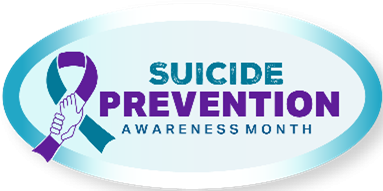September Suicide Prevention

September is Suicide Prevention Awareness Month. Together in Strength, Dignity, Hope, and Purpose, we can help those at risk be heard and find support.
Suicide is complex and determined by multiple combinations of factors, such as mental illness, substance misuse, chronic illness, trauma, painful losses, exposure to violence, and social isolation.
Below are the warning signs of suicide for youth and adults. Act if you notice these signs among family members, friends, neighbors, coworkers, or others. Suicide risk is greater if a behavior is new or has increased, and if it seems related to a painful event, loss, or change.
Adult Suicide Warning Signs
- Talking about or making plans for suicide.
- Acting anxious, agitated, or behaving recklessly.
- Talking about being a burden to others.
- Talking about feeling trapped or in unbearable pain.
- Increasing the use of alcohol or drugs.
- Talking about feeling hopeless or having no reason to live.
- Sleeping too little or too much.
- Withdrawing or feeling isolated.
- Showing rage or talking about seeking revenge.
- Displaying extreme mood swings.
- Chronic illness or serious physical health conditions.
Youth Suicide Warning Signs
- Expressing hopelessness about the future.
- Displaying severe or overwhelming emotional pain or distress.
- Increased physical symptoms—such as fatigue, headaches, and stomachaches—commonly associated with emotional distress.
- Changing or withdrawing from social connections or situations.
- Changes in sleep (increased or decreased).
- Anger or hostility that seems out of character or out of context.
- Recent increased agitation or irritability.
If you believe someone may be in danger of suicide:
- Call 911, if danger for self-harm seems imminent.
- Call or text 988 to reach the 988 Suicide & Crisis Lifeline to talk to a caring professional.
- Ask them if they are thinking about killing themselves. This will not put the idea into their head or make it more likely that they will attempt suicide.
- Listen without judging and show you care.
- Stay with the person or make sure the person is in a private, secure place with another caring person until you can get further help.
- Remove any objects that could be used in a suicide attempt.
For more education, awareness tools, and support, please visit:
https://www.samhsa.gov/about/digital-toolkits/suicide-prevention-month


